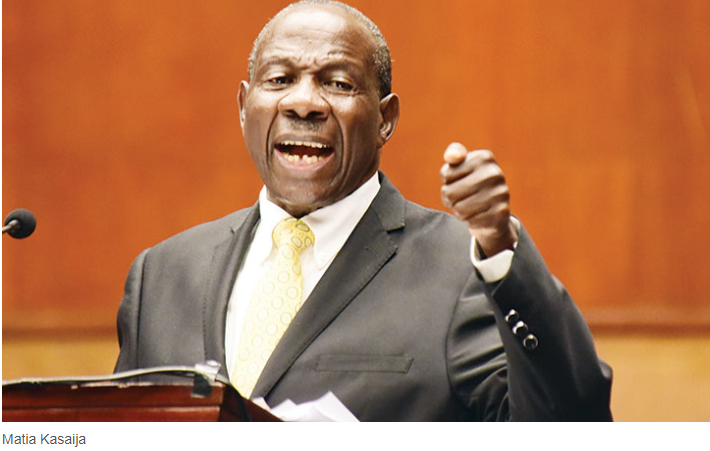Finance Minister Matia Kasaija won’t say if the government the proposed Standard Gauge Railway (SGR) is going to be axed, a wekk after the government has gotten Shs 94 billion for the rehabilitation of the Tororo-Gulu railway line that will revive the old internal tre-guage railway system.
This comes at the time when Uganda has not yet started construction of its eastern line running from Malaba to Kampala, about 273km which is expected to cost Shs8 trillion yet Kenya has finished its 266km line from Naivasha to Kisumu Port at Shs13 trillion. The cost has for a while been subject of debate, including a comparative-cost assessment by the parliamentary infrastructure committee which traveled to Ethiopia and issued its report in December 2016.
A potential expensive white elephant with unending issues over its financing, Hon. Kasaija was quoted in the media saying government has put on hold the SGR venture until unresolved issues with Kenya and China have been concluded.
Uganda now is trying to juggle modernising its metre gauge railway and the initial works on its SGR project, currently at the land compensation stage.
“It is apparent that SGR is going to take us a lot of time to complete. First, we have to wait for Kenya to reach at Malaba (the border) point then we can start,” Mr. Kasaija told Daily Monitor.
Mr Kasaija admitted that Uganda has currently taken a back seat on the SGR venture, but will resume ‘serious discussions once Kenya is about to reach’ the Ugandan side.
Phase II of the SGR project, covering the Nairobi-Naivasha section of the line, has faced multiple challenges since work on it began in the last quarter of 2017, including a court case filed by environmentalists opposed to the line’s passage through the Nairobi National Park.
Kenya, which is depending on Kampala to secure joint funding for the Kisumu-Malaba stretch, has already started laying the tracks for the $1.5 billion second phase of the line between Nairobi and Naivasha.
“Kenya also has its own problems which we cannot speak about in the public. We shall wait for them to settle but on our side, we have already compensated people from Tororo to Iganga. When they finish their part, we shall begin from there,” the minister revealed.
For it to make business sense, the proposed line has to reach Uganda in order to take over a huge chunk of the haulage business in the landlocked country ahead of the Tanzania-Rwanda SGR line.
It is also understood that Uganda Railways Corporation is taking over the operation from the project management unit after likable SGR project coordinator, Mr Kasingye Kyamugambi was relieved of his duties.
Kyamugambi’s crime, according to sources, is that he defended the $ 1.95 billion price the contractor; China Harbour Engineering Company (CHEC) has quoted for the 273km line between Kampala and Malaba that Museveni does not like.
SGR Uganda’s head of public relations and corporate affairs, Diana Apio, did not respond to our queries on the subject.
Inflated price?
CHEC’s woes started early last year when President Museveni, while on visit to Dar-es-Salaam, was told that Tanzania, which had just awarded its SGR contract, was constructing its line at a comparatively lower cost of $1.5m (Shs5.6b) per kilometre compared to Uganda’s cost $8.4m (approximately Shs30b).
At first, sources said at the time, this was interpreted as President Magufuli’s charm offensive to sway Uganda to gravitate towards the railway Tanzania is undertaking.
Ugandan technocrats flew to Tanzania a week later in panic to ascertain the facts where it was established that Tanzania’s SGR cost per km unit cost is $5m (Shs18b) and not $1.5m.
According to the parliamentary infrastructure committee report, the cost per kilometre of Uganda’s SGR is about Shs30b. On the other hand, Kenya constructed its first Mombasa-Nairobi line at (Shs27b) per km.
In the months following the March 2017 trip to Dar-es-Salaam, President Museveni during Cabinet meetings told officials to “move slow” on the Ugandan project pending further cost analysis and verification of the costs.
Later in November, Ms Azuba at the behest of President Museveni constituted a four-man independent committee led by Prof Edward Rugumayo and comprised of others, Makerere University engineering don Umar Bagambadde, former URC managing director Daudi Murungi and Mr Perez Wamburu, a retired ministry of Works chief civil engineer, to look into CHEC’s EPC contract and also benchmark on Tanzania’s costs.
In their final 81-page report, a copy seen by this newspaper, submitted last December the committee said in the recommendations that: “We note that the total costs given by CHEC are within the cost estimates provided by JB Gaulf for the Kampala-Malaba line.” Gaulf is the firm that undertook the project feasibility study.”
“These costs also include provisions for locomotives, rolling stocks and the Kampala URC station complex and the Tororo railway training school,” the report reads in part.
Why Uganda needs the SGR
Currently, 90 per cent of Ugandan-bound cargo (exports and imports) goes through Mombasa port at the Indian Ocean. It takes a trailer truck an average of five to seven days to move from Mombasa to Kampala, a 20 feet [32-tonne] container costing about $3,000 (Shs12m). The alternative to both the road and SGR is the existing metrE gauge railway which cannot move above 30km per hour, and whose concessionaire—Rift Valley Railways was kicked out early last year rendering the railway operations defective. Government has argued that the new railway is expected to reduce cargo transit times and costs by half.











